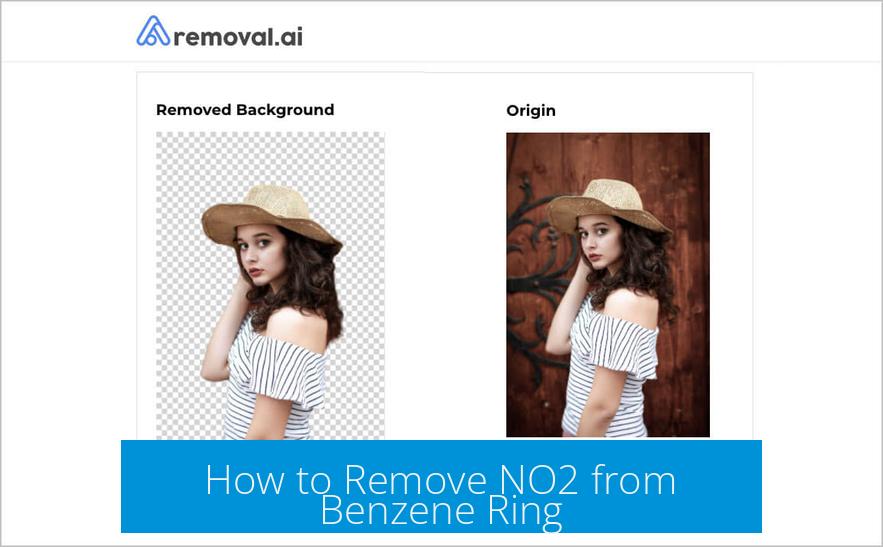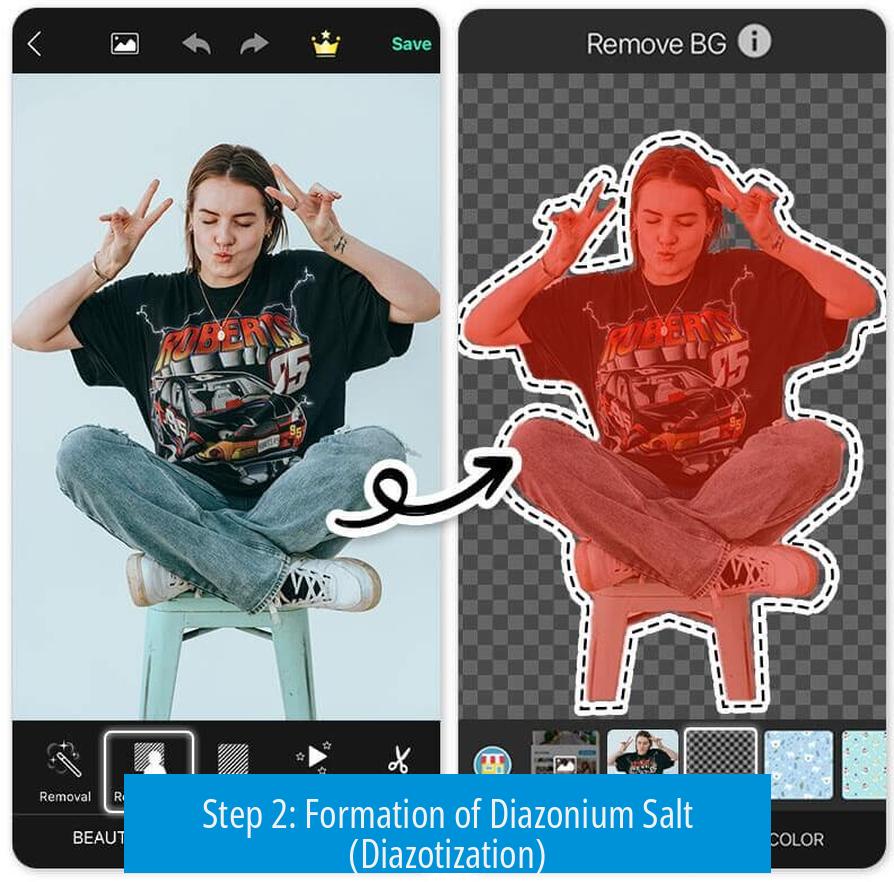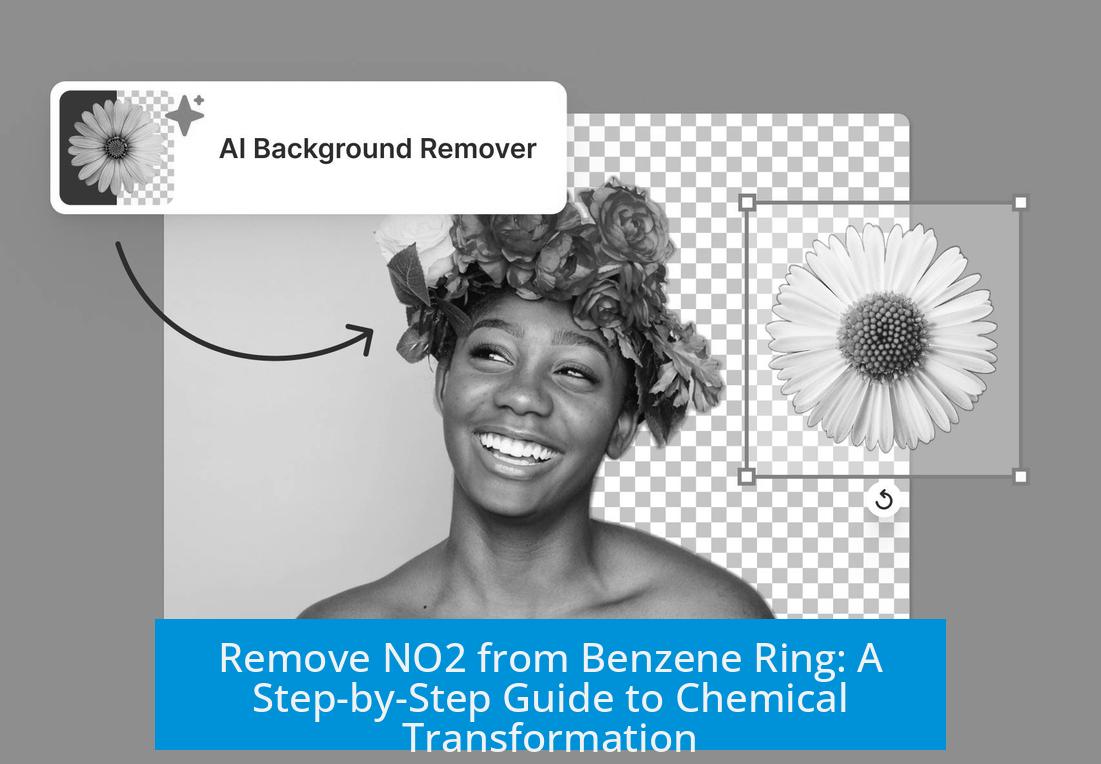How to Remove NO2 from Benzene Ring?

The nitro group (NO2) can be removed from a benzene ring by first reducing it to an amino group (NH2), converting the amino group into a diazonium salt, and then replacing the diazonium group with hydrogen. This multi-step process typically employs a sequence of reduction, diazotization, and reductive substitution.
Step 1: Reduction of Nitro Group to Amino Group

The nitro substituent (NO2) on the benzene ring undergoes reduction to form an aniline derivative (amine, NH2). Common reducing agents include zinc dust or iron filings in the presence of hydrochloric acid (Zn/HCl or Fe/HCl). This step converts the nitro group into a primary amine.
- Example reaction: R-NO2 + Zn/HCl → R-NH2
- Alternative reducing agents: Tin (Sn) with HCl can also achieve this transformation.
Step 2: Formation of Diazonium Salt (Diazotization)

The aniline group is then treated with sodium nitrite (NaNO2) and hydrochloric acid at low temperature (0–5°C). This process converts the amino group into an aryl diazonium salt (R-N2+ Cl-), which is a key intermediate for aromatic substitution reactions.
- Reaction conditions maintain low temperature to stabilize the diazonium salt.
- Reaction scheme: R-NH2 + NaNO2/HCl → R-N2+Cl-
Step 3: Replacement of Diazonium Salt with Hydrogen

The diazonium salt is then subjected to reduction using hypophosphorous acid (H3PO2). This step replaces the diazonium group with hydrogen, effectively removing the original NO2 substituent from the aromatic ring.
- Resulting reaction: R-N2+Cl- + H3PO2 → R-H
- Alternatively, ethanol (CH3CH2OH) or water with H2PO2 can be used in this step.
Summary of the Reaction Sequence

| Step | Reagents | Transformation |
|---|---|---|
| 1. Reduction | Zn/HCl or Fe/HCl or Sn/HCl | NO2 → NH2 |
| 2. Diazotization | NaNO2/HCl (0–5°C) | NH2 → Diazonium salt (N2+) |
| 3. Replacement | H3PO2 (or CH3CH2OH) | Diazonium salt → H (removal of substituent) |
Alternative Strategies
The nitro group is generally not an ideal blocking group because it is difficult to remove. Sulfonation is often preferred for reversible blocking of aromatic sites as it is easier to install and remove.
Therefore, chemists tend to avoid nitro substituents when planning syntheses requiring temporary blocking groups.
Key Takeaways
- NO2 group is first reduced to NH2 (aniline) using Zn/HCl, Fe/HCl, or Sn/HCl.
- The amino group undergoes diazotization with NaNO2/HCl at 0–5°C to form diazonium salt.
- Diazonium salt is reduced with H3PO2 to replace the group with hydrogen, removing NO2.
- This sequence is a variant of the Sandmeyer reaction.
- Sulfonation is often preferred over nitro groups as blocking groups due to ease of removal.
How to Remove NO2 from Benzene Ring? Mastering the Chemistry Puzzle
Curious about how to kick that stubborn NO2 (nitro) group off your benzene ring? You’re in luck. It’s a multi-step chemical dance famous among organic chemists, called the Sandmeyer reaction. Let’s break down the fascinating sequence that’s both practical and elegant.
Removing a nitro group from benzene doesn’t happen with a simple broom sweep. You can’t just tell it to “go away.” Instead, chemists cleverly transform the NO2 into a different group first, then swap it out completely. Let’s take an insider’s tour.
Step 1: Reduction of Nitro Group (NO2) to Amino Group (NH2)
The first step is a bit like giving the nitro group a makeover. The goal: convert that NO2 into a friendlier amino group NH2. This step sets everything else up.
How? By treating the compound with a reducing agent such as zinc in hydrochloric acid (Zn/HCl). Alternatively, you can use iron with HCl (Fe/HCl) or tin with HCl (Sn/HCl). These agents add hydrogen atoms, chopping off oxygens from NO2 and creating aniline (the NH2 group attached to benzene).
This reaction:
R-NO2 → R-NH2
Now you’ve got an aniline intermediate ready for the next stage. It’s much easier to work with than stubborn NO2.
Step 2: Turning Amino Group (NH2) Into a Diazonium Salt
Here’s where chemistry gets fancy. You take the amino group and, by adding sodium nitrite (NaNO2) and HCl at cold temperatures around 0–5°C, it transforms into a diazonium salt:
R-NH2 + NaNO2 + HCl → R-N2+ Cl− (diazonium salt)
Why does temperature matter? Cold conditions stabilize the reactive diazonium ion, preventing it from decomposing prematurely. The diazonium salt is a sort of chemical “gateway” — it’s highly reactive and versatile for substitutions.
Step 3: Swapping Diazonium for Hydrogen, the Grand Finale
Now for the clever bit: replacing the diazonium group with a harmless hydrogen atom, effectively erasing the original NO2 functionality from the ring.
This swap commonly uses hypophosphorous acid (H3PO2). Sometimes, ethanol (CH3CH2OH) or a mixture of hypophosphorous acid and water can be used. The reaction looks like this:
R-N2+ Cl− + H3PO2 → R-H
The diazonium group departs as nitrogen gas (N2), leaving behind a benzene ring without the NO2. Magic? No, chemistry.
The Big Picture: It’s All About the Sandmeyer Reaction
This whole three-step sequence—reduction, diazotization, and replacement—is called the Sandmeyer reaction. It’s a classic toolkit move for chemists wanting to remove or replace groups bound to benzene. It’s reliable, well-understood, and effective.
Here’s a quick summary table of this carnival of chemistry:
| Step | Reagents | Transformation |
|---|---|---|
| Reduction | Fe/HCl or Sn/HCl or Zn/HCl | R-NO2 → R-NH2 (Aniline) |
| Diazotization | NaNO2 + HCl at 0–5°C | R-NH2 → R-N2+ Cl− (Diazonium salt) |
| Replacement | H3PO2 (Hypophosphorous acid) or CH3CH2OH | R-N2+ Cl− → R-H (Benzene) |
Why Not Just Avoid Using Nitro Groups?
Here’s a pro tip: Nitro groups, while useful for blocking sites on benzene, aren’t the most forgiving characters in the lab. They’re tricky to remove compared to alternatives. If your goal is to protect a reactive site temporarily, sulfonation often becomes the better friend—a more easily reversed modification.
So, next time you’re planning a benzene functional group dance, consider if nitro’s worth the trouble or if you’ll thank yourself later by choosing sulfonate.
Practical Tips:
- Control temperature carefully during diazotization. Too warm, and your diazonium salt may decompose.
- Use fresh reagents for reduction and diazotization. Old or impure solutions reduce yields.
- Safety first. Diazotization releases nitrogen gas and involves acids—work in a fume hood with goggles.
- Monitor reaction progress. TLC (thin layer chromatography) or IR spectroscopy can confirm conversion steps.
Real World Example:
Imagine synthesizing a pharmaceutical intermediate requiring a clean benzene ring. If a nitro group has to go, the Sandmeyer sequence allows stepwise transformation while keeping the delicate molecule intact. This method helps medicinal chemists craft complex drugs with precision.
Or, in a teaching lab, demonstrating this sequence vividly shows how organic groups morph and how clever chemists remove seemingly “stuck” groups.
Wrapping Up the Nitro Exit Strategy
So, to remove NO2 from benzene, you reduce it to NH2, transform that into a reactive diazonium salt, and replace it with hydrogen. This classic sequence smartly navigates chemistry’s complexities through reduction, diazotization, and substitution.
While nitro groups pack a punch on reactivity and directing effects, they’re high-maintenance. Don’t be surprised if seasoned chemists suggest sulfonation as a less stubborn blocking alternative.
Next time you stare down a benzene with a nitro group, you’ll know: with zinc or iron, a chill in the lab, some hypophosphorous acid, and a bit of patience, you can reclaim a clean, NO2-free benzene ring!
How can the nitro group (NO2) on a benzene ring be initially converted for removal?
First, reduce the nitro group to an amino group (NH2). This can be done using reducing agents like Fe/HCl, Sn/HCl, or Zn/HCl.
What is the purpose of forming a diazonium salt in the NO2 removal process?
The amino group (NH2) is reacted with HCl and NaNO2 to form a diazonium salt (R-N2+ Cl-). This intermediate is essential for replacing the NO2 substituent with hydrogen.
How is the diazonium salt transformed to remove the NO2 group completely?
By treating the diazonium salt with hypophosphorous acid (H3PO2), the diazonium group is replaced with hydrogen, restoring the benzene ring without the NO2.
What is the overall reaction sequence to remove NO2 from a benzene ring?
Reduce NO2 to NH2, then diazotize with NaNO2 and HCl at 0–5°C, and finally treat with H3PO2. This sequence is a Sandmeyer-type reaction.
Are there better alternatives to using NO2 as a blocking group on benzene rings?
Yes, sulfonation is preferred because nitro groups are harder to remove after attachment. Using sulfonation avoids the complex removal steps of the nitro group.





Leave a Comment